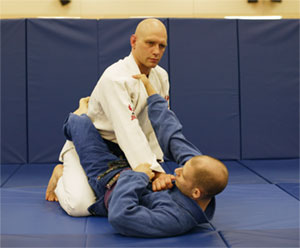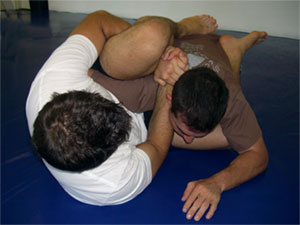By Stephan Kesting and Elliott Bayev
Principal Photography by Keith Haist
Originally Published in Ultimate Grappling Magazine
Brazilian Jiu-jitsu terminology can be both confusing and intimidating to people beginning their grappling careers. Some martial arts – Kodokan Judo for example – have a central organizing body and relatively well-defined terminologies. Jiu-jitsu, however, is a young art that is constantly evolving and as a result, produces limitless new positions and variations.
Of all the positions, techniques and submissions in Brazilian Jiu-jitsu, the guard position has spawned the greatest amount of variations and terminology. There are many different guards: Closed Guard, Open Guard, Spider Guard, Half Guard, Butterfly Guard, de la Riva guard just to name a few. Furthermore, guard positions usually have further variation, depending on exactly how you grip with your hands and where you place your feet
It is important to recognize that there is no single superior method of guard, and also that all guards are not created equal for every environment. Some positions work best with the gi, others work with or without the gi, and the presence or absence of striking can completely change the value of a position. Certain positions are great for winning submission grappling tournaments, but may be very risky in a self defense or mixed martial art (MMA) context.
Ultimately the type of guard(s) you specialize in will depend on many things, including your physical attributes, your competitive environment and the style of your instructor. The purpose of these three articles is to provide you with a reference for some of the more common guards, to help you understand some of the terminology used in class, and maybe give you some ideas on how to develop your own game.
This first article discusses some of the more common Closed Guard variations; subsequent articles will discuss variations of the Open Guard and Half Guard.
Basic Closed Guard
 The Closed Guard used with a basic sleeve and lapel grip |
 With an overhooking lapel grip and wrist control |
 Keeping the opponent close by controlling an arm and the head |
 Using the Closed Guard to rest for a moment; not recomended for MMA! |
 Maintaining the Closed Guard against a standing opponent |
This is the style of guard most often taught to beginners, and it is still effective at the highest levels of competition. Like all Closed Guards, it locks your opponent between your legs, offering great control, preventing the opponent from improving position and providing you an opportunity to attack with sweeps and submissions.
A ‘relaxed’ position in the Closed Guard can be used for resting in BJJ or submission grappling, but it can get you very hurt in an MMA or self-defense scenario. If you use the Closed Guard to defend against strikes you MUST keep your opponent’s head down, close to you, or he will have the distance and leverage to land some very damaging blows. If you simply can’t break his posture then immediately switch to a form of Open Guard that keeps him away, out of striking distance.
High Guard

Trapping the opponent’s right shoulder in
the High Guard
The High Guard, also known as the Crooked Guard or Climbing Guard, requires you to climb your legs up to trap at least one of your opponent’s shoulders. Once trapped here, your opponent is in continuous danger from armbar, triangle and sweep attacks.
The High Guard requires less flexibility than the Rubber Guard (discussed next), but is similar, as the legs are used to keep your opponent’s posture down. This is a great guard for both BJJ and MMA, because it is difficult for your opponent to strike you or pass your guard without giving you the sweep or submission.
Rubber Guard
 Eddie Bravo demonstrates one variation of the Rubber Guard |
 Attacking from the Rubber Guard |
The Rubber Guard, here demonstrated by Eddie Bravo who coined the term, is a method of keeping your opponent’s posture broken by locking your legs and feet into a very high position around his neck. Other guard players, perhaps most notably Nino Schembri, have developed guard attacks along similar lines, though Bravo has certainly helped popularized it in North America.
This is an effective guard for MMA as it limits the opponent’s striking options and keeps the guard player safe to attack. It has been used successfully by a number of MMA fighters, most recently by Shinya Aoki, a Japanese MMA Star. Flexibility in the hips and legs is very important to apply this guard effectively and to avoid injury. Being able to touch your foot to your face is probably the minimum amount of flexibility required. If you can put your foot behind your head then you may be able to make your opponent’s life miserable from your back using the Rubber Guard.
A link to a triangle choke attack sequence from the Rubber Guard.
Leghook Guard

Holding your own leg and your
opponent’s head in the Leghook Guard
The Leghook Guard position has been used in the UFC several times, most notably by Dean Lister to set up a triangle on Alessio Sakara at UFC 60. You can achieve the Leghook Guard when your opponent places an arm on the mat; as soon as he does this you trap his arm by bringing your leg up towards your shoulder and then link your hands, encircling both his head and your own leg.
This position keeps an opponent’s posture broken. In an MMA or self-defense context this is very important because with his posture this far forward it is difficult for your opponent to use his arms to strike you with very much force.
Your main attacks from this position are the omo plata and the triangle choke; if you can bring your free leg over your opponent’s shoulder then the triangle is right there for you (see a triangle setup from the Leghook Guard here).
Shawn Williams Guard
 Shawn Williams working the Shawn Williams Guard |
 Shawn Williams deeper into an attack sequence |
This guard is named in honor of Renzo Gracie blackbelt Shawn Williams who is known for using this position. It is closely related to the leghook guard except that both your arms have been moved to one side of your opponent’s head – rather than encircling the head – making it harder for your opponent to counter you (see 1st photo).
Once again the most common attacks are the omo plata and triangle choke, typically used in combination. Shawn Williams demonstrates this guard in both pictures, and is shown partway through a triangle attack in the second photo.
| There’s a ton of information the Closed Guard (and all the other most important BJJ positions) in the Roadmap for Brazilian Jiu-Jitsu package, produced by Stephan Kesting and available at Grapplearts.com | The next articles in this series are:
Other relevant articles include: |
The post A Glossary of Guards Part 1: The Closed Guard appeared first on Grapplearts.

